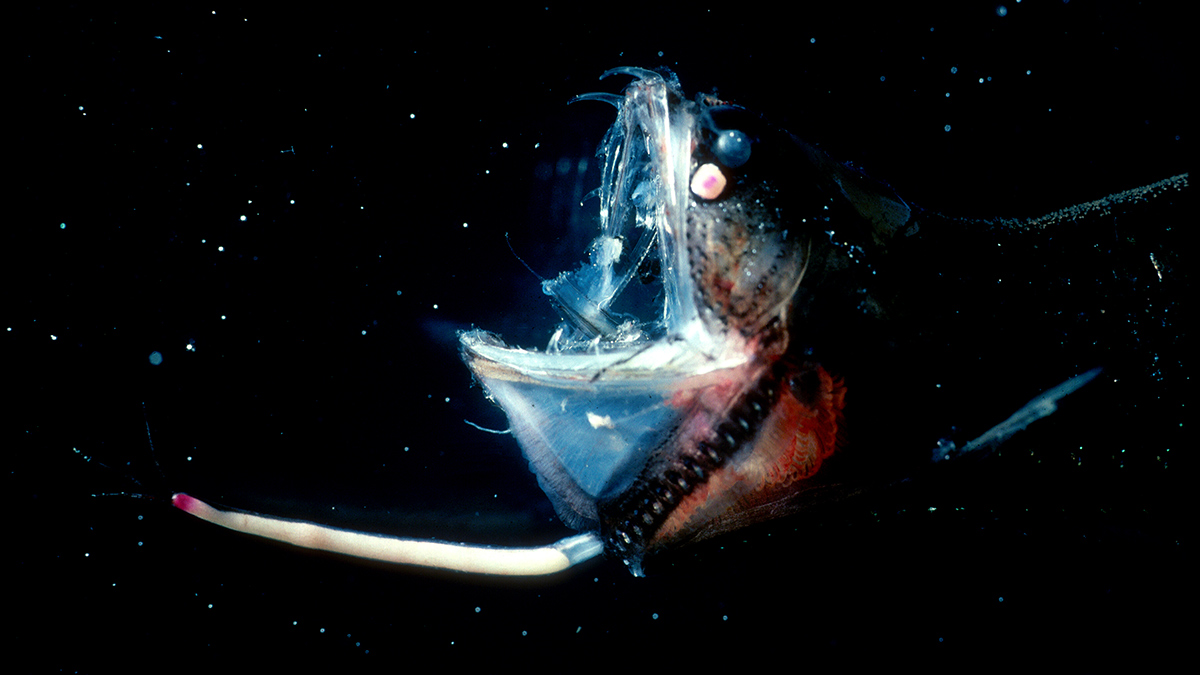Hearing the name “dragonfish,” you would probably expect an enormous, monstrous beast with long fangs. Although the sight of this fish is enough to make you scream in horror, it is surprisingly small. However, unlike many of the frightening creatures on this list, it is indeed dangerous to humans through its potent venom. In this post, we will dive into fascinating qualities of the elusive dragonfish.

The dragonfish is surprisingly small—only about six and a half inches in length. Despite its size, it is not to be underestimated. These creatures are ferocious predators of the deep. They are known to feast upon fish over half its size. These small specimens pack quite the punch.
Although they are prey upon many types of fish, they are also the prey of other sea creatures. For example, red flounder fish are known to eat dragonfish. The dragonfish is essential to the food chain.

One defense mechanism that the dragonfish yields is its highly toxic venom. It emits a poison that is incredibly dangerous and deadly to its victims. The poison is located in special poison sacks, and it is excreted through its spines.
Dragonfish venom is best characterized by the excruciating pain it causes almost immediately after the sting. The pain can then last from a few hours up to multiple days. The body reacts to the toxin through swelling and a rise in body temperature. However, the affected area often loses sensitivity.
Although it is possible to be stung by a dragonfish, it is uncommon since dragonfish live so deep in the ocean, and it is unlikely to find one accidentally. The main threat to humans is consuming dragonfish. It is considered a delicacy and is said to have a unique nutty flavor. Highly-trained chefs must properly remove the fish’s poison in order to prepare this dish.

In an environment where light cannot reach, dragonfish produce their own light through bioluminescence. It has bioluminescent photophores on its jaw which allow it to attract prey and even communicate with other dragonfish.
Some species of dragonfish can produce and see red light. This is highly uncommon among sea creatures because red light waves poorly penetrate the dense water. This is why almost all sea creatures create blue light, which penetrates water much more efficiently.
Because other fish cannot see red light, they are experts at camouflage. Additionally, they have their own wavelength of light to communicate with other dragonfish.

Dragonfish also have extremely precise vision. Their eyes are chlorphyllic, allowing them to gather every bit of light possible in the dark ocean. They can see their way around in even the dimmest of conditions. This ability demonstrates just one of the many fascinating ways species have evolved to adapt to their environments over time.
The dragonfish is an intriguing creature that packs many advanced survival tactics in a small body. It is a classic example of not underestimating a creature based on its size.
I never heard about the Dragonfish before; it’s so fascinating how so many features can exist within one organism. It’s interesting how their bioluminescence has be credited to allowing communication between Dragonfish; how did scientists determine this to be the case? Do they work in groups, or do they travel alone? Why would they need to communicate with other Dragonfish? Is it only for mating purposes? Are Dragonfish endangered if they’re considered a delicacy? Are their habitats also effected by deep-sea trolling and fracking? This blog has piqued my curiosity; thank you for that.
This is a new creature to me and this really just leaves me wondering why people want to put their lives at risk to eat a food. I’ve wondered this about people eating pufferfish before and I really can’t see why the risk is worth eating something that probably doesn’t taste better than chicken. Regardless, I think this is a really cool creature and I find it interesting that they have great vision, given that they live at the bottom of the ocean. It is my understanding that many deep ocean dwellers have very limited sight or no sight at all. Their sight seems to be a really great adaptation that gives them a leg up over their prey.
I am astounded by this creature! I have never quite seen anything like it. I am not really one to venture in eating exotic animals or fish, but I have to say, that dragonfish looks delicious! I do have to ask though, where are these fish located in the sea, and at which level? In the past, I have done some ecological studies and saw that fish and creatures living in the abyss, the deepest, darkest, and coldest part of the ocean, have these “freaky” looking creatures due to the adaptations they acquired for their unique environment. You mention that they are at the bottom of the ocean, so this is probably what you are referring to. I also see that the fish itself is highly toxic, so how do they go about cooking it in a way that is safe to eat? Has there ever been a circumstance where the poison was “dormant” and it affected someone who ate it afterwards? Great post by the way, I absolutely loved reading it!
I was surprised by the size of the Dragonfish, I was expecting it to be larger than its actual size. But the after-cook of Dragonfish has a less-threatened face than before. But I don’t think I would give it a try because as you had mentioned, the biggest threat to humans was to consume it. While reading, I was wondering how scientists know all these facts about dragonfish when dragonfish are at the bottom of the ocean. Do they do experiments on them or accidents are happening so there is evidence that the sting is not fatal?